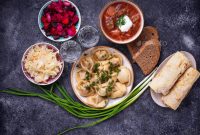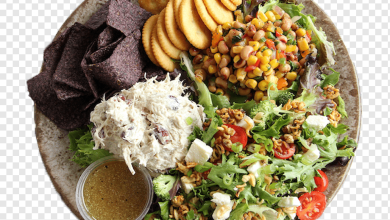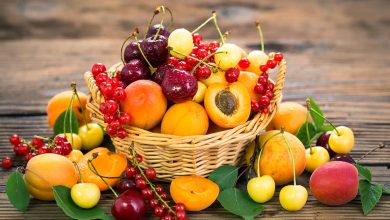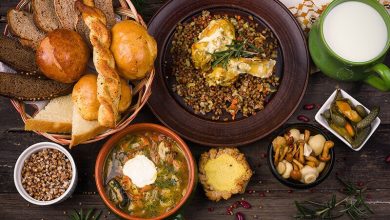TRADITIONAL RUSSIAN CUISINE
Cuisine of Siberia: dumplings, shanti and tea
Like the northern peoples, in Siberia one of the main dishes was fish. True, other varieties were preferred in these parts: sturgeon, salmon, whitefish. Some species were not considered fish at all. Burbots were given to dogs, and pigs were fed with bream and ide.
Fish was also cooked differently than in the North. Omul, whitefish, mukluk or Neelam were salted, other types were baked in sour cream, stuffed with porridge with mushrooms and onions, dried in the air or in an oven. Of lightly salted fish, small toguna was especially valued: if it was cooked correctly, then it smelled of fresh cucumbers. In the 19th century, it was called Sosvinskaya herring and was delivered to St. Petersburg – to the imperial table and to the best metropolitan restaurants. Fish smoking began only in the 19th century.
For the filling, several types of meat were usually mixed: poultry, beef, pork, venison or elk. The dough was kneaded not with water, but with tea, so that frozen dumplings would be stored longer and remain juicy. They were often taken with them on the road to quickly cook on a fire or directly in a samovar.
Bread was an obligatory part of the Siberian meal. Until the 17th century, it was brought from beyond the Urals, then they began to grow it themselves. In addition to bread, other pastries were also served at the table: open shanti with hearty or sweet filling, folds pinched along the edges, crispy brushwood fried in oil.
Each meal was accompanied by a tea party. Merchants and other wealthy people preferred “flower” tea, which was prepared from the top leaves of the tea bush. This drink had a pleasant taste and delicate aroma. Of the cheaper varieties, “brick” tea was common: it was sold in pressed tiles.
Far East: piano-se, hyo and seaweed borscht
None of the traditional cuisine of Russia had such an abundance of seafood as in the Far East. On the Pacific coast, not only numerous varieties of fish and caviar were eaten, but also crabs, squids, octopuses, and scallops. The first Russian settlers borrowed recipes from the indigenous Far Eastern peoples: Nicks, Adages, Evenks. They learned how to cook dried sigma fish, which they ate with lingonberries and wild garlic, roast red deer meat and other game on a fire, and salt edible fern shoots for the winter.

They kept the recipes of their traditional cuisine, but changed them to fit the new living conditions. This is how borscht made from seaweed, fish soup with salmon, dumplings with squid and other dishes unusual for the rest of Russia appeared.
The culinary traditions of Primo rye were also influenced by the cuisine of neighboring countries – China, Korea, Japan. The most popular dishes in the Far East were Korean fish hyo marinated in vinegar, Japanese yakitori chicken skewers, Korean pies-se, which were cooked in a steam bath. The filling of such pies could be any – meat, vegetable or sweet.
Ural: echpochmak, Georgian woman and secekunchiki
Ural cuisine has always been famous for its abundance of pastries. In the vicinity of Yekaterinburg and Perm, small, slightly larger than dumplings, pies were prepared. Their name comes from the word “cut” – finely chop: this is how meat was cut for the filling. In the Orenburg province, the “king of pies” was called karmic, which was often served at weddings. The filling for such a pie was different types of meat, mushrooms, eggs, sauerkraut. Layers of different fillings were separated by thin pancakes.
The Urals is a multinational region, so the culinary traditions of different peoples are mixed here. Russian residents have learned how to cook Turkic beshbarmak – a dish of stew and pieces of dough. They put lamb in it, as was customary among the Bashkirs, or beef and potatoes, as among the Kazakhs. The Tatars adopted the recipe for echpochmak pie with meat, onions and potatoes. The filling for him was not prepared in advance, but put raw into the dough.
Mushrooms were another popular product in the Ural cuisine. They were fried with onions and eaten as a separate dish, added to the filling for pies and dumplings, served with porridge and meat, dried and salted for the winter. Ural housewives often cooked Georgian soup with fresh or salted forest mushrooms. Despite the name, not only milk mushrooms were put in such a dish, but also chanterelles, aspen mushrooms, mushrooms, ressala – any mushrooms that could be found in the nearby forest.

Volga region: koala, pilaf and strudel
Different peoples of Russia lived on the banks of the Volga: Chuvash, Tatars, mountain and meadow Mari, Ezra, Moksha. Each of them preserved ancient culinary traditions, which were gradually adopted by the Russians. Some recipes have been passed from one kitchen to another in their original form, while others have replaced certain products or cooking methods with more familiar ones.
Of the Central Russian culinary traditions in this region, numerous types of cabbage soup and porridges, dishes from boiled or baked river fish, vegetables and wild berries have been preserved. Cold milk soups were prepared from raspberries, blueberries and wild strawberries, viburnum and bird cherry were added to fillings for pies or a hot sweet koala dish.
The main dishes of the Mari were soups and cereals. In cabbage soup, instead of cabbage, they often put gout, sorrel, nettle or other herbs. Soups were prepared with fish or meat, potatoes, viburnum, mushrooms were added to them.
From the Tatar cuisine in the Volga region, pies with various fillings, beshbarmak, pilaf were popular. Traditionally they were cooked with hare, lamb or horse meat. Muslim Tatars did not eat pork. However, recipes for these dishes with pork, beef and chicken soon appeared in Russian cuisine. Spices and seasonings, except for dill, parsley and onions, were almost never used in the Volga region.
They followed their own culinary traditions. German housewives prepared mashed potatoes and pork schnitzels, dough dumplings and chicken noodle soups. Homemade sausages and a baked goose were always served on the festive table. Unlike other peoples of the Volga region, the Germans drank a lot of coffee, sometimes replacing it with a substitute of chicory or cereals.



